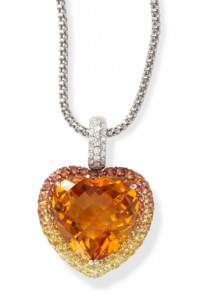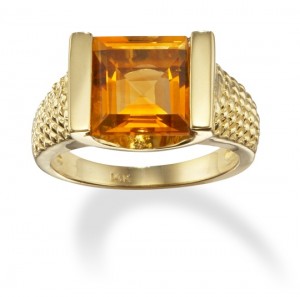 Citrine gets its name from its color, the citrus yellow of lemons and it is has historically been incorrectly referred to as Gold Topaz despite not being one of those precious stones. Other common names include Bahia, Madeira and Rio Grande Topaz. These deceptive terms have led to Topaz needing the adjective “pure” before it to distinguish it from misnamed Citrine.
Citrine gets its name from its color, the citrus yellow of lemons and it is has historically been incorrectly referred to as Gold Topaz despite not being one of those precious stones. Other common names include Bahia, Madeira and Rio Grande Topaz. These deceptive terms have led to Topaz needing the adjective “pure” before it to distinguish it from misnamed Citrine.
Where does Citrine Gemstone Originate?
Citrine is fairly rare in nature and most Citrine available commercially today are heat treated Amethyst (both of these stones are forms of the mineral Quartz). This gemstone has been found in a variety of places, Brazil, Madagascar, Spain and Scotland. Its popularity grew in the 1930s when large quantities of Citrine were sent to Germany from Uruguay and Brazil by expatriate cutters in South America.
It is relatively inexpensive compared to the Diamonds, Sapphires and Topaz stones of similar color and this made it accessible beyond the very rich in society. Thus, the popularity of Citrine use in jewelry has grown in recent times.
Given its lack of “cleavage”, it is a robust gemstone and available in larger sizes, which meant the cutters could make Citrine in a whole range of sizes for women’s jewelry collections. It was also used for men’s items such as cufflinks and rings and at times in furniture ornamentation.
Queen Victoria loved gemstones and was particularly fond of Citrine because it was a local stone from the Cairngorms. It led to its use for kilt pins and brooches in Scotland particularly. Likewise skilled craftsmen making swords used it in Scotland for making sword handles.
What are the physical properties of citrine?
Color Pale yellow – red/brown
Crystal 6 sided prism/pyramid
System triagonal – hexagonal
Mohs scale (hardness) 7
Diaphaneity Translucent to nearly opaque
Specific gravity 2.65
Citrine has little in the way of refractive properties but its appeal is the mellow soft look it provides for jewelry. It is the birthstone for November bringing warmth to the chilly winter days that are coming. If you are looking for a piece of yellow gemstone jewelry, there are few yellow gemstone options, especially for the budget conscious. Citrine is a much more affordable stone than the other main options, Diamond and Sapphire. There are some other alternatives as well, such as Chrysoberyl or Tourmaline but they tend to have be tinged slightly greenish.
One point to note is that the confusion over Topaz and Citrine can be a slight problem in that they can have very different values. Natural citrine is rare yet it does not carry the value it might because it can be regarded as imitation Topaz and lose its appeal accordingly.

what color is Citrine Gemstone?
Citrine’s prime color is yellow though it also comes in reddish brown. It has a mellow and soothing appearance and that sets it apart from many other stones. The coloring of the stone comes from the presence of iron in silicon dioxide.
The Madeira citrine, the color of the drink, has historically been more valued than the basic yellow but the latter matches very well with pastel colors and so has found favor more recently. Citrine gemstones that veer away from the more common lemon color to a radiant yellow and reddish brown tend to be more valuable. Not unnaturally the value of Citrine can depend very much on the intensity of the color.
Are large Citrine stones common?
Like most quartz, Citrine can be found in large sizes so there is no extra value for a large stone unlike with many other gemstones.
What is the best cut for Citrine gemstone?
Citrine is fairly hard and scratch proof. It makes it an ideal stone for cutting and as it is relatively inexpensive, a large stone set with smaller more expensive stones can give you a lot for your money. Stones larger than 10 Carats are often cut into many different designs, both traditional and more modern. Whilst it is not renowned for its clarity it tends to provide a mellow alternative which can be attractive in the right setting.
Are most Citrine stones treated or enhanced?
The color in Citrine is key to its value. It was in early the 1800s that it was discovered that Amethysts and some Smokey Quartz would slowly turn yellow with heat treatment. An expert can fairly easily identify the natural from the heat treated, the former with cloudy striping as opposed to the subtle stripes of the latter. All heat treated stones also tend to have a reddish tint whilst natural Citrines are mostly pale yellow.
History and Myth
This quartz was known to the Greeks in ancient times and was used for ornaments and jewelry even then. It has been variously called the “Sun” stone with properties to heal a snake bite. The Romans called it the stone of Mercury, the messenger god. Deposits were found in Scotland in the 1700s and they were used by weapon makers for dagger handles.
Summary

Citrine has the beauty to enhance any jewelry and can provide the color that you want without breaking the bank. You can buy also Citrine as the center piece for jewelry with smaller and more expensive stones surrounding it for their sparkle or color contrast. Be aware however that the market is full of heat treated Amethyst today so you should ask if your heart is set on natural Citrine to ensure you get what you pay for.
